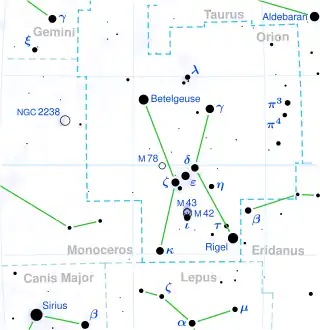 | |
| Observation data Epoch J2000 Equinox J2000 | |
|---|---|
| Constellation | Orion |
| Right ascension | 05h 30m 47.05091s[1] |
| Declination | +05° 56′ 53.2925″[1] |
| Apparent magnitude (V) | 4.20[2] (4.43 + 5.80)[3] |
| Characteristics | |
| Spectral type | B5V + ? + B7V[3] |
| U−B color index | –0.56[2] |
| B−V color index | –0.13[2] |
| Astrometry | |
| Radial velocity (Rv) | +18.60[4] km/s |
| Proper motion (μ) | RA: +5.10[1] mas/yr Dec.: –33.30[1] mas/yr |
| Parallax (π) | 10.77 ± 0.64 mas[1] |
| Distance | 300 ± 20 ly (93 ± 6 pc) |
| Absolute magnitude (MV) | –0.63[5] |
| Details | |
| 32 Ori A | |
| Mass | 5.0[6] M☉ |
| Radius | 2.9[7] R☉ |
| Luminosity | 388[5] L☉ |
| Surface gravity (log g) | 4.40[8] cgs |
| Temperature | 16,020[9] K |
| Rotational velocity (v sin i) | 169[8] km/s |
| Age | 65[8] Myr |
| Other designations | |
| Database references | |
| SIMBAD | data |
32 Orionis is a triple[3] star system in the equatorial constellation of Orion. It has the Bayer designation A Orionis, while 32 Orionis is the Flamsteed designation. This system is visible to the naked eye as a faint point of light with a combined apparent visual magnitude of 4.20.[2] It is located approximately 303 light-years away from the Sun based on parallax,[1] and is drifting further away with a radial velocity of +18.6 km/s.[4]
The system is a member of the eponymous 32 Orionis group, a young, nearby association of 46 co-moving stars first discovered in 2007.[11]
The primary component of this system is a B-type main-sequence star with a stellar classification of B5V[12] and a magnitude around 4.43. This is actually a spectroscopic binary with an orbital period of 3.964 days and eccentricity of 0.38.[3] The unseen companion has an estimated mass of 0.6 times that of the Sun.[13] Component B, at an angular separation of 1.08″ from the primary, is a class B7V star with a magnitude of 5.8, orbiting with the primary at a period of 614 years and eccentricity 0.22.[14]
References
- 1 2 3 4 5 6 Van Leeuwen, F. (2007). "Validation of the new Hipparcos reduction". Astronomy and Astrophysics. 474 (2): 653–664. arXiv:0708.1752. Bibcode:2007A&A...474..653V. doi:10.1051/0004-6361:20078357. S2CID 18759600. Vizier catalog entry
- 1 2 3 4 Ducati, J. R. (2002). "Catalogue of Stellar Photometry in Johnson's 11-color system". CDS/ADC Collection of Electronic Catalogues. 2237. Bibcode:2002yCat.2237....0D.
- 1 2 3 4 Eggleton, P. P.; Tokovinin, A. A. (September 2008). "A catalogue of multiplicity among bright stellar systems". Monthly Notices of the Royal Astronomical Society. 389 (2): 869–879. arXiv:0806.2878. Bibcode:2008MNRAS.389..869E. doi:10.1111/j.1365-2966.2008.13596.x. S2CID 14878976.
- 1 2 Kharchenko, N.V.; et al. (2007). "Astrophysical supplements to the ASCC-2.5: Ia. Radial velocities of ~55000 stars and mean radial velocities of 516 Galactic open clusters and associations". Astronomische Nachrichten. 328 (9): 889. arXiv:0705.0878. Bibcode:2007AN....328..889K. doi:10.1002/asna.200710776. S2CID 119323941.
- 1 2 Anderson, E.; Francis, Ch. (2012). "XHIP: An extended hipparcos compilation". Astronomy Letters. 38 (5): 331. arXiv:1108.4971. Bibcode:2012AstL...38..331A. doi:10.1134/S1063773712050015. S2CID 119257644. Vizier catalog entry
- ↑ Tetzlaff, N.; et al. (2011). "A catalogue of young runaway Hipparcos stars within 3 kpc from the Sun". Monthly Notices of the Royal Astronomical Society. 410 (1): 190–200. arXiv:1007.4883. Bibcode:2011MNRAS.410..190T. doi:10.1111/j.1365-2966.2010.17434.x. S2CID 118629873. Vizier catalog entry
- ↑ Allende Prieto, C.; Lambert, D. L. (1999). "Fundamental parameters of nearby stars from the comparison with evolutionary calculations: Masses, radii and effective temperatures". Astronomy and Astrophysics. 352: 555–562. arXiv:astro-ph/9911002. Bibcode:1999A&A...352..555A. Vizier catalog entry
- 1 2 3 David, Trevor J.; Hillenbrand, Lynne A. (2015). "The Ages of Early-Type Stars: Strömgren Photometric Methods Calibrated, Validated, Tested, and Applied to Hosts and Prospective Hosts of Directly Imaged Exoplanets". The Astrophysical Journal. 804 (2): 146. arXiv:1501.03154. Bibcode:2015ApJ...804..146D. doi:10.1088/0004-637X/804/2/146. S2CID 33401607. Vizier catalog entry
- ↑ Zorec, J.; et al. (2009). "Fundamental parameters of B supergiants from the BCD system". Astronomy and Astrophysics. 501 (1): 297–320. arXiv:0903.5134. Bibcode:2009A&A...501..297Z. doi:10.1051/0004-6361/200811147. S2CID 14969137.
- ↑ "32 Ori". SIMBAD. Centre de données astronomiques de Strasbourg. Retrieved 2019-07-10.
- ↑ Bell, Cameron P. M.; et al. (June 2017). "A stellar census of the nearby, young 32 Orionis group". Monthly Notices of the Royal Astronomical Society. 468 (1): 1198–1220. arXiv:1703.00015. Bibcode:2017MNRAS.468.1198B. doi:10.1093/mnras/stx535.
- ↑ Hoffleit, D.; Warren, W. H. (1995). "Bright Star Catalogue". VizieR On-line Data Catalog: V/50. Originally Published in: 1964BS....C......0H (5th ed.). 5050. Bibcode:1995yCat.5050....0H.
- ↑ Tokovinin, A. (2008). "Comparative statistics and origin of triple and quadruple stars". Monthly Notices of the Royal Astronomical Society. 389 (2): 925–938. arXiv:0806.3263. Bibcode:2008MNRAS.389..925T. doi:10.1111/j.1365-2966.2008.13613.x. S2CID 16452670.
- ↑ Malkov, O. Yu.; Tamazian, V. S.; Docobo, J. A.; Chulkov, D. A. (2012). "Dynamical masses of a selected sample of orbital binaries". Astronomy & Astrophysics. 546: A69. Bibcode:2012A&A...546A..69M. doi:10.1051/0004-6361/201219774. Vizier catalog entry